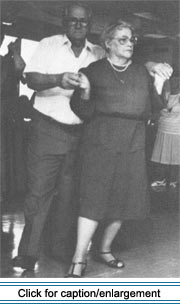|
 French-language
folk song continues in the Upper St. John Valley as a living oral tradition.
Perhaps the best known Maine Acadian traditional singer is Ida Roy of
Van Buren. Her enormous repertoire includes old ballads and lays, locally
composed songs and comic music-hall ditties, original commemorative songs,
and complaintes. Complaintes are poems from the oral tradition
that usually commemorate a tragic event, often sung to the melodies of
religious hymns (J. C. Blesso, pers. comm. 1993). Because of her tremendous
repertoire and her efforts to keep the song tradition alive, Mrs. Roy
was recently nominated for a National Heritage Award by the Maine Arts
Commission. Another singer is Constance "Connie" Morin Derosier of St.
Agatha, Maine. Illustrating the importance of family in transferring culture,
Mrs. Derosier inherited her love of singing and her songs from her father,
Eddie Morin, a singer of local reputation. However, of the 16 children
in her family, Connie is reportedly the only one to have learned her fatherís
songs. French-language
folk song continues in the Upper St. John Valley as a living oral tradition.
Perhaps the best known Maine Acadian traditional singer is Ida Roy of
Van Buren. Her enormous repertoire includes old ballads and lays, locally
composed songs and comic music-hall ditties, original commemorative songs,
and complaintes. Complaintes are poems from the oral tradition
that usually commemorate a tragic event, often sung to the melodies of
religious hymns (J. C. Blesso, pers. comm. 1993). Because of her tremendous
repertoire and her efforts to keep the song tradition alive, Mrs. Roy
was recently nominated for a National Heritage Award by the Maine Arts
Commission. Another singer is Constance "Connie" Morin Derosier of St.
Agatha, Maine. Illustrating the importance of family in transferring culture,
Mrs. Derosier inherited her love of singing and her songs from her father,
Eddie Morin, a singer of local reputation. However, of the 16 children
in her family, Connie is reportedly the only one to have learned her fatherís
songs.
 The
fiddling of Alfred Parent of Van Buren was recorded on a cassette entitled
Traditional Music of Maine, Vol. 1, produced in 1988 by
the Maine Folklife Center at the University of Maine (Orono). His recorded
repertoire, including "Rag Time Annie," seems to be related more to a
broader old-time repertoire than to any set of specifically Acadian tunes.
Similarly, outstanding young Valley fiddlers like Bobby Kelly, Terri Charrette,
and Mark Morris maintain a repertoire that is representative of old-time
Anglo-American fiddling. Lionel Doucette is another well-respected local
fiddler. The
fiddling of Alfred Parent of Van Buren was recorded on a cassette entitled
Traditional Music of Maine, Vol. 1, produced in 1988 by
the Maine Folklife Center at the University of Maine (Orono). His recorded
repertoire, including "Rag Time Annie," seems to be related more to a
broader old-time repertoire than to any set of specifically Acadian tunes.
Similarly, outstanding young Valley fiddlers like Bobby Kelly, Terri Charrette,
and Mark Morris maintain a repertoire that is representative of old-time
Anglo-American fiddling. Lionel Doucette is another well-respected local
fiddler.
There were several performances by step dancers, some quite spontaneous,
at the "Violons díAcadie" program presented during the 1991 Acadian Festival.
These performances, along with observations made by folklife fieldworkers
at a dance and a house party in Fort Kent, suggest that a localized step-dancing
tradition continues in the Valley.
|
 |
 |
 Group
dancesósquare, round, and line dancesóare performed at the Forever Young
Club in Madawaska, as well as at Lí‚ge díor clubs in New Brunswick.
In 1991 researchers observed the following dances performed by a crowd
of mostly elderly citizens: "Lady of the Lake," several "sets carrÈs,"
"Le Pinto," "Ton ëti chien Madame," the "Continentale," "Paul Jones,"
and the "Tucker." Group
dancesósquare, round, and line dancesóare performed at the Forever Young
Club in Madawaska, as well as at Lí‚ge díor clubs in New Brunswick.
In 1991 researchers observed the following dances performed by a crowd
of mostly elderly citizens: "Lady of the Lake," several "sets carrÈs,"
"Le Pinto," "Ton ëti chien Madame," the "Continentale," "Paul Jones,"
and the "Tucker."
In a 1993 focus group in Frenchville, several Maine Acadians noted the
change to more individually oriented entertainment, such as television
and recorded music, in the present when compared to community dance and
music events in the past:
. . . weddings, automatically "Lady of the Lake" and "John Paul
Jones." Every wedding had that; that was tradition. Now, forget it!
They donít have that, and itís [become] a conversation piece. This is
why I set them apart [music/dance] because now we donít do that. When
I was a young girl, a long time ago, well this was part of an evening.
There was a lot of music especiallyónot dancing, we [my family] were
not dancersóbut music!
The Catholic Church has both encouraged and discouraged music and dance
in the Upper St. John Valley. For example, there is evidence that local
clergy discouraged traditional music and dance. Residents report that
during much of the 20th century, they were taught by members of the Catholic
religious orders that dancing was a sin that required the absolution of
confession.
 Yet
music is part of religious-oriented celebrations in the Valley. During
the summer of 1991, the town of Van Buren, Maine, celebrated the significant
role of the Catholic sisters as local educators and cultural emissaries.
In June nine Catholic choirs from both sides of the St. John River commemorated
the centennial of the arrival in the Valley of the Good Shepherd Sisters.
Songs were sung during a joint concert in three languages: French, English,
and Latin. Some of the selections performed had cultural relevance to
Maine Acadians. For instance, "Ave Maris Stella," dedicated to the foremost
symbol of Acadian nationalism, was sung by the choir from Saint Gerard
Church in Grand Isle, Maine; the choir from Saint-Michelís in Drummond,
New Brunswick, sang "Au del‡ de toute frontiËre;" and "La riviËre Saint-Jean"
was sung as a finale by a combination of all attending choirs. The choir
from St. Brunoís in Van Buren has recorded an album entitled Hommage
‡ LíAcadie which includes "Le pÍcheur acadien," "Evangeline," "Les
trois cloches," "Partons, la mer est belle," and several other selections
that have Acadian references. Yet
music is part of religious-oriented celebrations in the Valley. During
the summer of 1991, the town of Van Buren, Maine, celebrated the significant
role of the Catholic sisters as local educators and cultural emissaries.
In June nine Catholic choirs from both sides of the St. John River commemorated
the centennial of the arrival in the Valley of the Good Shepherd Sisters.
Songs were sung during a joint concert in three languages: French, English,
and Latin. Some of the selections performed had cultural relevance to
Maine Acadians. For instance, "Ave Maris Stella," dedicated to the foremost
symbol of Acadian nationalism, was sung by the choir from Saint Gerard
Church in Grand Isle, Maine; the choir from Saint-Michelís in Drummond,
New Brunswick, sang "Au del‡ de toute frontiËre;" and "La riviËre Saint-Jean"
was sung as a finale by a combination of all attending choirs. The choir
from St. Brunoís in Van Buren has recorded an album entitled Hommage
‡ LíAcadie which includes "Le pÍcheur acadien," "Evangeline," "Les
trois cloches," "Partons, la mer est belle," and several other selections
that have Acadian references.
Jazz and the Big Band sound were popular in the Valley from the 1930s
to the 1950s. Country music has also had an impact upon the musical traditions
of Maine Acadians. When Jeannette Cyr Daigle moved from the Valley to
Lewiston in the late 1930s, she listened to Hal Lone Pineís live country-and-western
music radio show. After her singing talent came to the attention of Lone
Pine, she was invited to sing on his show. In 1938ñ39, she adopted the
radio name of "Daisey" and made a mark as a singer of American country
songs. Today her son, George Daigle, organizes the annual Green River
Bluegrass and Country Music Festival in RiviËre-Verte, New Brunswick.
|
|

